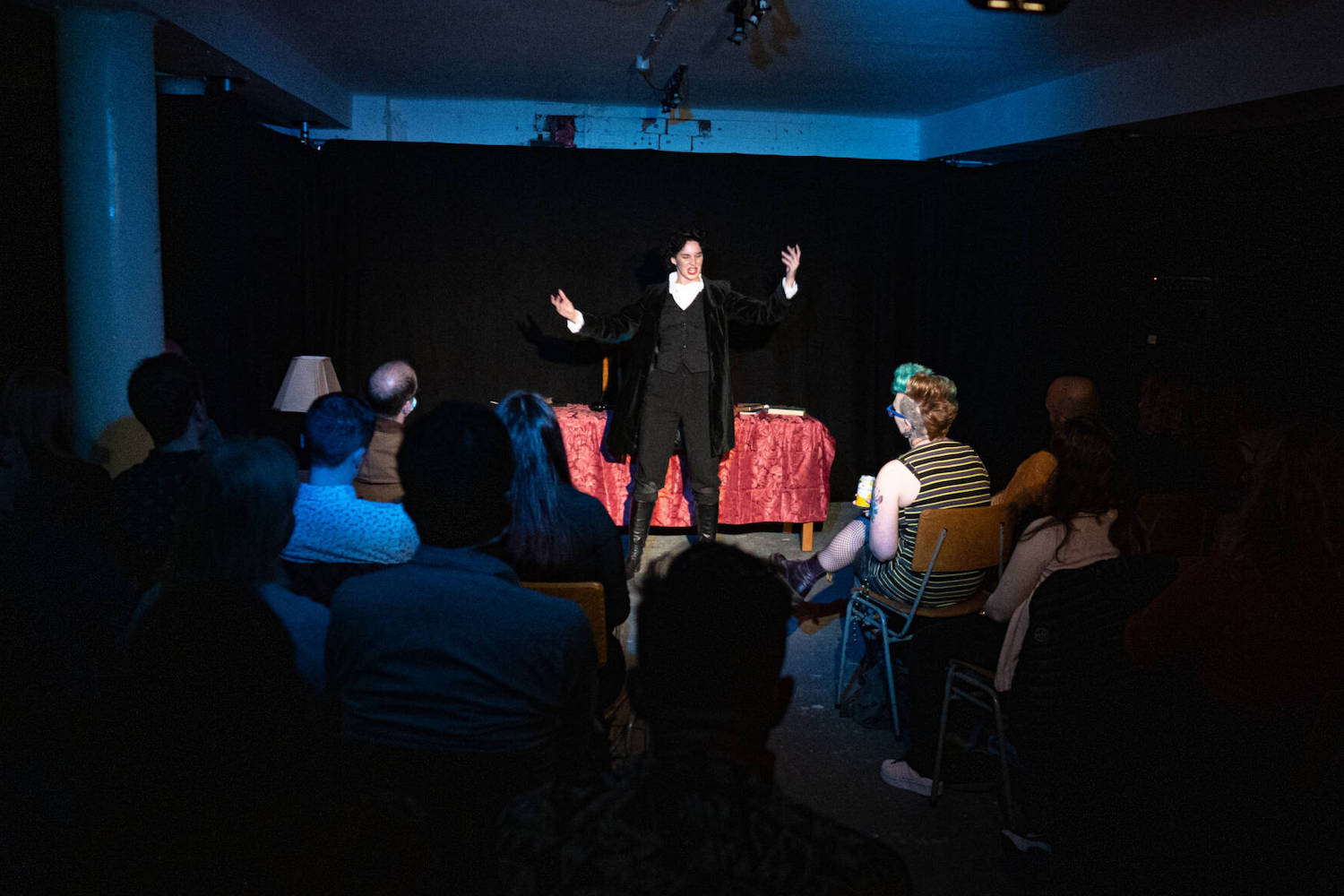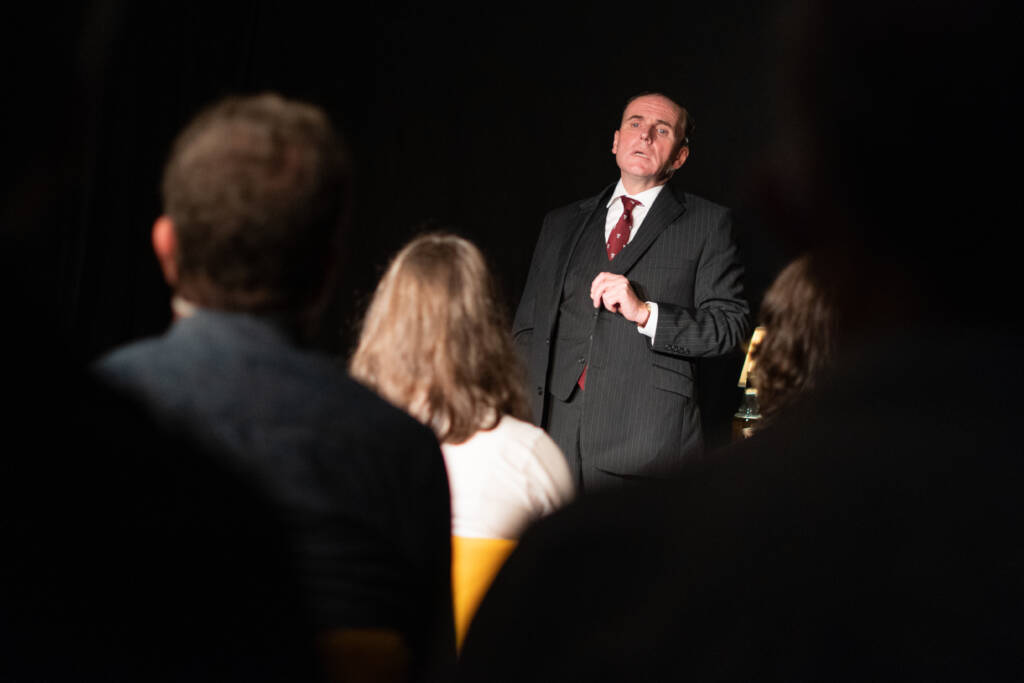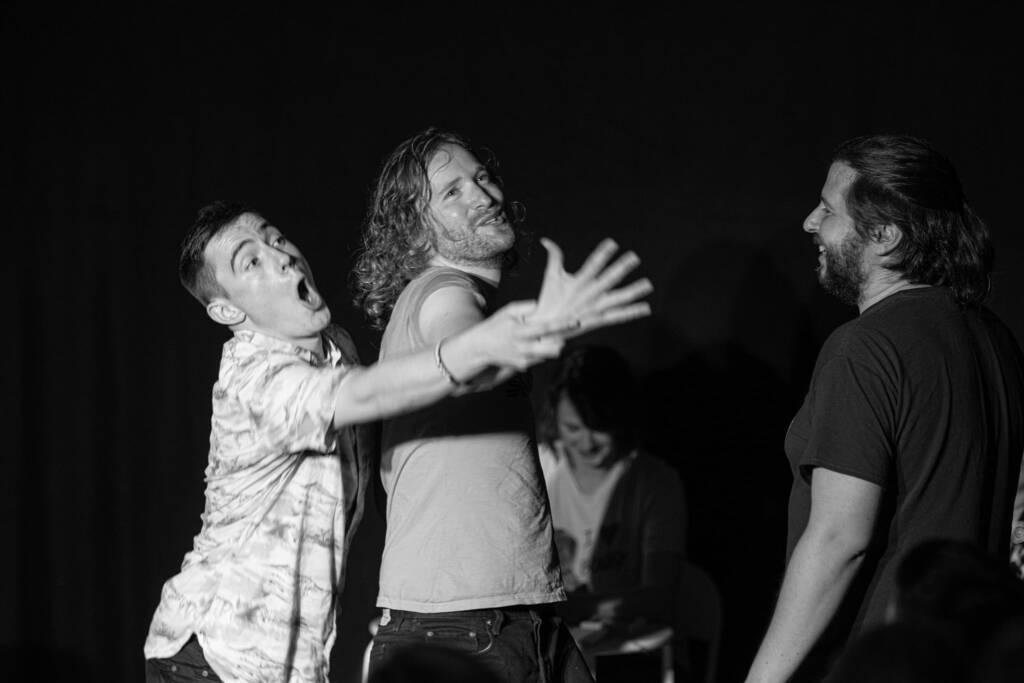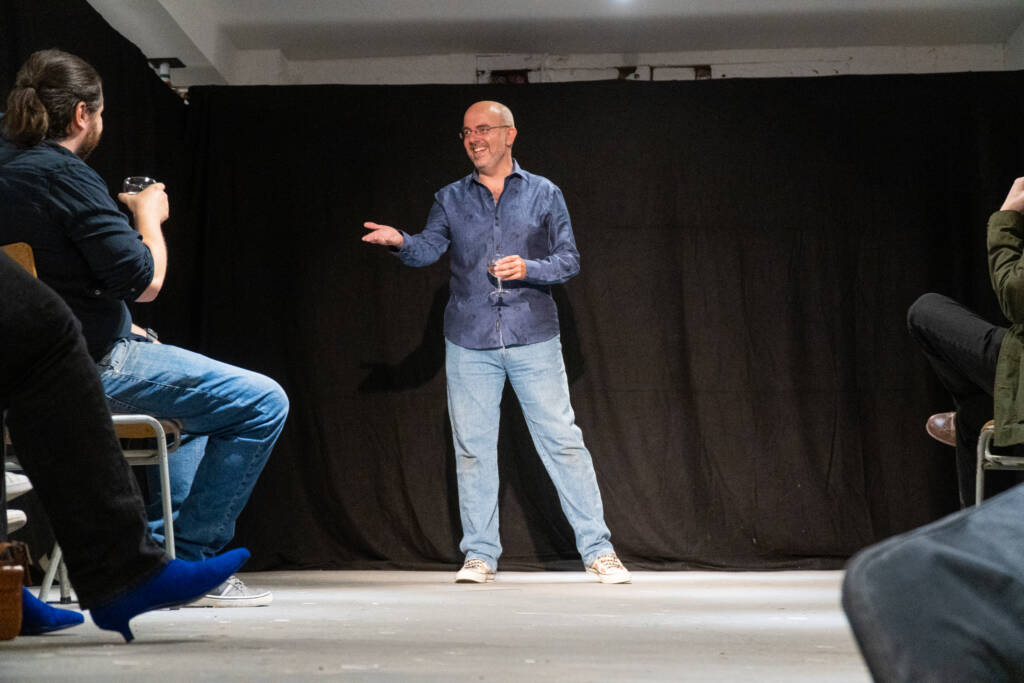
29.06.23

Often, these projects sit on a foundation of an individual’s particular passion for their chosen creative field but end up providing more benefit to the broader community than was ever expected.
This time, we chatted with JD Henshaw, who is, amongst many things, the organiser of Dundee Fringe, a festival that’s brought the best of theatre, comedy, music and community events together in the city since 2021. We talked about how his experience producing work in other fringe festivals had shaped his vision for Dundee’s version, the importance of having a secure space to take risks as creatives, and just how much we can achieve when we work together.
Creative Dundee: To start us off, I’d love it if you could give us a little bit of context – what makes a festival a fringe festival?
JD Henshaw: I guess I’ve done the thing I said I’d never do: I’ve created a fringe festival that isn’t on the fringe of anything. But fringe has come to mean a certain type of performance – whether that’s theatre, comedy, spoken word poetry – and a certain type of performance length, which sort of sits at around 60 minutes, no interval. Ideally, you want it to be a festival to celebrate as wide a range of art as you possibly can, with one art form not taking priority over another and, for the artists, you want it to provide an opportunity for risk and experimentation.
Dundee Fringe is designed to bring together artists and creatives who are at different stages of development: we have people who are at rehearsed reading stage, which means they’ve still got scripts in hand and they’re still working things out, people who are work-in-progress stage, which means they’re knocking the edges off of it and still trying to get to grips with the staging; and then something that’s tour ready, it’s polished and perfect, it’s in its final form. And with the range of work on show, you’re hoping to celebrate and diversify people’s tastes, so that someone who says, “I love comedy but theatre isn’t for me” might just happen to take a punt on a play because, “Oh, it was only £7 to go and see that other show, and it reads really well and I’ve been in the room and I like the space and I’m having a good time – I’ll take the chance.” And for all you know, that’s the moment where that person suddenly realises that they love spoken word, or music, and those performances are for them. And that’s what you want a fringe to achieve.

CD: What was the catalyst that kick-started it all for you?
JDH: I’d been toying with the idea for a really long time, and I’d had a couple of false starts towards the festival before, but I think the experience I had working through the pandemic in other fringes really kick-started it all. I never stopped fringe-ing all the way through lockdown; we had a Brighton Fringe in October 2020 that was allowed to happen and we were pretty much the only major event in the country that ran. At the time, people didn’t see the cost-effectiveness, or some people’s funding relied on them literally locking down their building and not opening. As Sweet Venues [JD’s venue management company] we had a terrible time through lockdown, I didn’t see any money particularly; our postcodes weren’t quite right, our tax thresholds weren’t what people wanted to see. A lot of the stuff that we do to make sure that we maintain an affordable environment for artists worked heavily against us in getting funding, which was a really frustrating position to be in.
I did get quite disillusioned with it all – I was angry and upset at some of the behaviour I was seeing, at the lack of help. But I decided to see the opportunity in it, using it to prove you can make work happen in any circumstance. Because my big fear – and we’re still seeing some of that now – is that you end up with stagnation, a bottleneck of work that causes more damage than the years we lost. We keep losing because people drop out of the system and no longer make work. I know a few folk who have found other jobs – it was already a fragile way to make a living and the pandemic made it even more fragile and lots of people thought, “Actually I’m better off driving vans for supermarkets.” And you’re like, “Oh my god, they made the most exquisite pieces of art I’ve ever seen and it’s gone forever.” It wasn’t just creatives – it was technicians, designers, we’ve lost loads of talent. So when I began to see that happening, I thought, surely it was worth getting folk on stage, even if it was only for 15 audience members, to make sure work still happened, even if it wasn’t commercially viable? It felt – and I realise it sounds saccharine – but it felt like a really important part of my responsibility to make sure work was still going on. I thought, do you know what? There are hungry people, I’m hungry, we can make work happen. Let’s just do it together.
CD: You organised the first Dundee Fringe in 2021, when we were still very firmly in the pandemic. What was it like?
JDH: It was one of the toughest times to do it, which kind of made it one of the best times to do it. I knew I could do it safely and, no matter what, I knew I was in a head space that if something suddenly happened and shifted, I could cope with it and we would get through it. I learned a lot about cleaning supplies during that time. I think our big thing for us was to find ourselves in a place where we could make plans that had enough flex and enough humanity in them that we could make good work together. And people wanted it. And I sent money to every artist that performed. That felt amazing. Audiences were super happy, grateful to be there, wanted to buy more shows. So from the bare minimum level of bums on seats, tickets sold, it happened. And it was just about working together and being really open and honest.
CD: You’ve worked in lots of other fringe festivals, both across the UK and internationally. Why was Dundee the place to set this up?
JDH: I think Dundee’s just in a really great headspace for it – it’s a city with a real doing spirit. It was more than just wanting to make sure I was making work where I lived. I’ve been working and producing shows and running venues at fringe festivals for a long time and I’ve seen some festivals that, to be honest, have now got themselves to a place that you could lift them out of the cities they’re in and put them somewhere else and you wouldn’t be able to tell the difference.
I wanted to make sure we were supporting Dundonian work, whatever that meant; as long as you were living, working, or being part of Dundee, you’re Dundee as far as I’m concerned. I wanted to make a festival that belonged to our city, where you couldn’t have one without the other, and again that’s holistic. It’s making sure we support local artists, local audiences, that they’re the foundation of everything, and the things we’re bringing into that is so that we can then spread that network and build better experiences for everybody. I wanted to make sure we were reaching out to people that we’re not seeing; maybe we’re seeing them turn up to writing nights but I’ve never actually seen their work. What we’ve actually found though – I think by virtue of having that built into the rules – is that we’ve heard from a lot of local artists, and that those people who’ve been involved previously have talked to each other and other locals too, so inherently that balance is being roughly maintained. Probably 60-70% of the work is being generated in Dundee and then 30-40% of the work is being invited in, because you do still want a mix.

CD: How does Dundee Fringe compare to the others you’ve worked in?
JDH: So, I’ve been lucky in the fact that I’ve had the time to work in these other festivals and absolutely take really good ideas that are sitting in all of them, they’ve all got great ideas. But I think the ones that honestly work best are the smaller scale ones, the more boutique festivals. A lot of the larger festivals – the likes of Edinburgh, Brighton, Adelaide, Perth [Australia] – are struggling with the same problems at the moment, where the market forces around them are making the festivals themselves totally unsustainable for venues and artists.
Venues are now relying on selling beer to put on art, which is why you now see more and more of these super venues that are basically big beer gardens. That doesn’t make them the bad guy – they’ve built monsters because they’re trying to keep their systems running. The economies around bigger fringe festivals are superheating and multiple threads of that economy are superheating simultaneously, which makes it impossible to make any art on an effective budget. This means it’s only very well-established, very well-funded organisations, rich people who can afford to do it, or people who are willing to burden themselves with debt. And all this affects audience behaviour too. People coming to those bigger festivals say, “Oh, I’ve been to the Fringe! It was amazing, I sat in a beer garden and I ate a £10 burger and I had three pints and I spent all my money.” and you’ll ask them what shows they saw, and they’ll say, “Oh nothing, I just soaked up the atmosphere.” You know, when does cultural tourism become cultural voyeurism?
And it’s hard to see. I’ve worked half my life in Edinburgh Fringe, and I love it. I wouldn’t have been doing the things I’m currently doing had I not cut my teeth in that festival. But I’ve pulled my venue out of that festival. The cost for me to stay in accommodation in Edinburgh for one week during the festival last year – and it was still a half-hour bus journey from the outskirts – was the same as I was paying for a room for a month in 2019. 400% increase in the last four years isn’t any kind of rate of inflation anywhere, no matter which way you want to cut it. A fringe festival should be a home for experimentation. But how do you risk in an environment where you can’t afford to sleep in the city? So with Dundee Fringe, we’re not looking to replicate that scale, I’m looking more to festivals like Prague Fringe for inspiration. The smaller ones have a tighter focus, more opportunities to support artists, and more opportunities to speak to their artists on a day-to-day basis, particularly during the day-to-day festival, and make connections and create a genuinely supportive atmosphere. That’s what I want Dundee’s to be.
CD: Having seen the issues with the bigger festivals first hand, are there steps you’re taking now with Dundee Fringe to protect it from that fate?
JDH: A lot of it comes down to scale, consciously keeping it at a manageable size. It’s tricky because you want growth, and you want the growth to be natural and organic. Dundee Fringe has already grown – we doubled in size from year one to year two, which is amazing, but coupled with everything else I’m talking about, it also makes me go, “Okay, how do we look after that?”. At the moment, it’s just the one venue in Dock Street Studios*, but we’ll eventually need other venues for it across the city too, but I guess my perspective on that is to make sure that we make sure the venues all come under the banner of Dundee Fringe rather than lots of individual venues putting work on and setting their own terms and conditions. It’s about making sure that the artists are always getting exactly the same deal no matter where they are. We want to make sure we’re removing competition rather than creating it, so that the money and the support and marketing is the same no matter what venue individuals are performing in. And that every artist who comes in knows that they’re always in the best venue for them, and that there’s no hierarchy in the venues in terms of prestige or money. No market force; please just keep market forces out of it.
* Unfortunately, since completing this interview, Dock Street Studios has permanently closed.

CD: How have you found audience reactions to what you’ve done so far
JDH: I think there’s a real appetite for it but, more generally at the moment, we are in a bit of a cycle of audience tentativeness. People are buying tickets for things they recognise; that band that they know they already like, that comedian they’ve seen on the telly, they’re booking that piece of theatre where they recognise the title, the writer, the cast. But I don’t think that that’s necessarily a change in their desire to see more experimental work, it’s a change in their bank balance. In the bigger fringes, we’re seeing everything becoming very safe and makes it very difficult to introduce that experimental work.
With Dundee Fringe, we have less expectation and so we’ve got the space for that experimentation, for different stages of development. For us, a big part of getting audiences on board with that is being really clear with what they can expect from their ticket and what their money will do. We’ve tried to make a space where tickets are affordable but also really well explained, so that when they buy a £5 ticket for a rehearsed reading, they know they’re going into a show that’s nowhere near finished yet. But it exists! It’s a real, living thing and the £5 you just put in helped them pay for a rehearsal room or pay everyone’s bus fare, or bought everyone their lunches as they helped build the show. But also, explaining the value of just being in the room as an audience member, you know, they provide a massive value to artists. You’re not just a passive consumer of art in that space; those writers, those performers, they’re going to turn round to you and say, “So what’d you think?” It’s not just your applause that will serve, you’ll have a conversation.
CD: Being part of the development process is going to be a totally different experience than what you’d get at a more mainstream show.
JDH: It’s a huge shift in approach and we need to make sure audiences, and creatives as well, understand it. Thinking about the audiences as part of our creative process rather than the end of our creative process. I guess it ties into trying to create spaces that allow risk, spaces that someone can afford to fail in but a space that people can do it in a really supportive way. Where work can come together and when you come to the end of that little run you’ve done and you say, “I’ve knocked out some ideas and I’ve actually realised that maybe the thing I originally wanted to talk about in their work isn’t quite right.” And that you go home from that experience with direction, rather than looking at your bank balance and having to have a big cry.
CD: Are there other forms of developmental support that you provide?
JDH: We want to have a fringe that is a really strong space for artists to network with each other, and to learn how to create a sustainable approach to touring and their creative processes. In terms of the application process, rather than going with the open access system that you’ll see in other festivals, we use a supported access model, which means some work could be submitted but if I don’t think it’s quite ready, I could go back to them and say, “How can we support bringing that out?”. Maybe that’s helping them get actors together, maybe it’s rehearsal space, maybe it’s something else; but it’s about getting people developmentally where they need to be.
We also do a lot of business model and peer-to-peer workshops, so that people can actually work out how to make a living from their craft. Peer-to-peer in particular is really important, particularly in a festival set-up where you have all stages of development, because someone who’s been touring their pieces for the last decade is going to know great spaces that are looking for work that would have taken more time to find out about on your own. Finding out about venues, and the details about how different venues operate, like, “These theatres all do splits, these do commission, these theatres will do this or that. That theatre’s great but it’s got a terrible light rig.” All those little things that mean that artists can then spend their time writing those emails and letters to those other places that will work for the particular show they’re putting on instead of wasting their time. There is only so much energy to go around, and most artists didn’t set out to be producers but a lot of them are self-producing.
The other big thing is just creating the space for these artists to come together. How can they keep being brilliant artists if they’re not seeing other work, if they’re not getting the chance to engage with it, give feedback on the stuff that’s asking for it, get feedback when they want it? So much of that comes from having the opportunity to sit afterward and have a coffee, have a pint in an environment where you’re all just pure buzzing about what you do together. And I think Dundee is really good for that, I think the city’s in a really good headspace collectively for it. We’re all quite conversational and ‘doing’ people, you know, like “let’s do a thing!”, and fringes that let people engage with each other are such creative hotbeds. You and I might make completely different work, but we can be mutually excited about it. Everyone becomes part of the same water and lifts each other up. And I think it’s a really gorgeous thing.

CD: Speaking of Dundee specifically, is there anything you’d love to see in the city that could support the work you do? What would you love to see happening next?
JDH: That’s tricky! Dundee’s got so many good things, I think we’re really lucky. Dundee Design Festival, NEoN, Wasps Studios, Christmas in Dundee, Book Yer Ane Fest. I think Dundee City Council is pretty driven towards making cool shit happen here and the various collectives around the city are equally driven to making that happen. I guess now, it’s about those things being amplified and enhanced, all of them getting to be the best version of themselves. If for every Art Night, we have a Wasps Studio; for every Dundee Fringe, we have a community picnic; if each one of these things is reflected by the polar opposite, it feeds the whole thing. I would love more collaboration between it all though. All of these things are happening and that’s great and it all bubbles away, but you want it to bubble up. The more these things happen, the more that’s going on in Dundee’s cultural ecosystem, the more it supports the next thing that comes along. So it’s about making sure that the support and the networks are in place to ensure that those things that are doing really well keep doing really well; that then helps the new and fresh stuff coming up the ladder.
To be clear, it’s not that we’ve never had it so good, because it’s tough right now. There’s never enough funding, there are never enough resources. But we’ve got the potential to have never had it so good, if everybody pulls together – not just the creatives, but the council, funders, philanthropists. I think Dundee’s got this real drive in the right places to allow us to do that, but there’s no perpetual motion to it all, we need to keep driving it. It’s just getting all our heads in one room and scoping these things out, finding people to work with, finding ways to ensure not everything is just in the city centre. It’s about collaborative working and the stuff that ‘we’ do together, not just what ‘I’ did. I guess I just want Dundee to keep Dundee-ing.
A big thank you to JD for sharing with us! Dundee Fringe will be returning to the city between Fri 15 and Sun 24 September. Keep up to date with the plans over on their Twitter, Instagram and Facebook, and their website too.
Whilst you’re here, why not catch up on our previous Collective in the City interviews with Make-That-A-Take Records, Volk Gallery, Elfie Picket Theatre, Biome Collective, Hotchpotch, CHIP Collective and Double Door Studios too?

If you would like to support us in creating even better content, please consider joining or supporting our Amps Community.